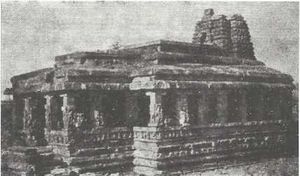Durgā Temple (of Aihole)
From Hindupedia, the Hindu Encyclopedia
By Swami Harshananda
Location[edit]
Aihole is a small town in the Bijapur district of northern Karnataka.
Significance[edit]
One of the ancient group of temples built out of stone and preserved as archaeological monuments is at Aihole. The Durga temple is a major building of this group. The temple is situated inside a structure that resembles a ‘durga’ or fort. Hence it is known as Durga temple though the temple is not dedicated to the goddess Durgā.
Characteristics[edit]
- It is assigned to the period A. D. 600.
- Temple is of the Cālukyan style.
- The apsidal plinth resembles Buddhist caitya in architectural style.
- The vimāna[1] is of the nāgara type.
- There is no image of any deity inside the sanctum.
- There is a passage around it meant for pradakṣiṇā or circum-ambulation.
- The pillars carrying the roof are rectangular in shape and of a very simple design.
- The relief figures etched on the outer walls and on the pillars in the front include:
References[edit]
- ↑ Vimāna is called as the tower above the main shrine.
- The Concise Encyclopedia of Hinduism, Swami Harshananda, Ram Krishna Math, Bangalore

